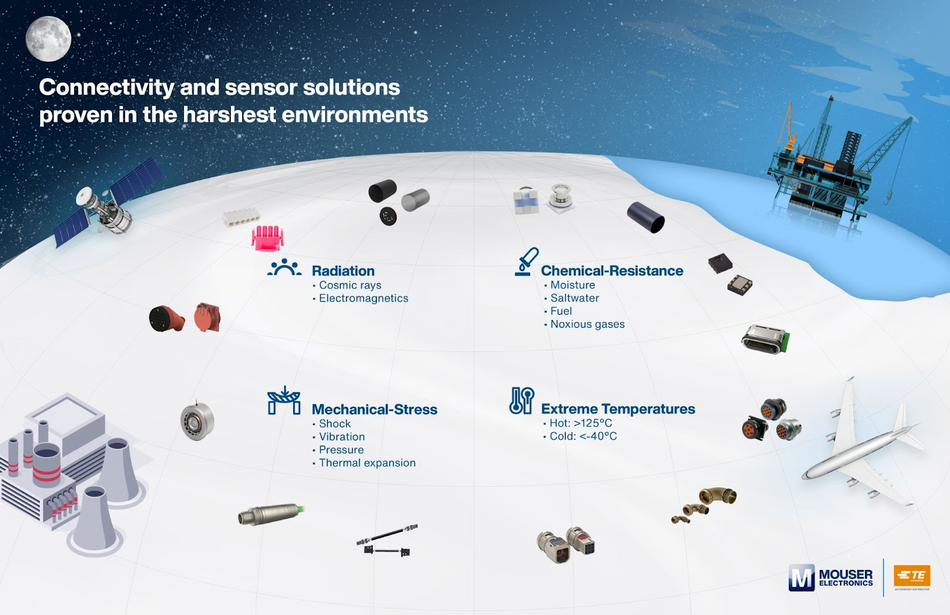Connectivity and Sensing Technologies Proven in the Harshest Environments
Introducing the Connectivity and Sensing in Harsh Environments Series: Advancements in aerospace, defense, construction, power systems, automobiles, nuclear reactors, and various other fields have made it necessary for systems engineers to ensure reliable performance in the harshest environments.
This is the introductory article to a 6-part series featuring topics on Connectivity and Sensing in Harsh Environments. The series will showcase how highly engineered connectivity and sensing solutions enable advancements in manufacturing, transportation, construction, healthcare, energy generation, and consumer products. This series is sponsored by Mouser Electronics. Through the sponsorship, Mouser Electronics shares its passion for technologies that enable smarter and connected applications.
Electronic systems and circuits are constantly under stress. Devices are susceptible to being compromised when introduced to harsh environmental conditions. Harsh environmental conditions can include exposure to extreme temperatures, temperature cycling, ingress of liquids or particulates, electrostatic discharge (ESD), electromagnetic interference (EMI), vibrations, and physical impact.
To deal with such extreme environments found in almost all the manufacturing and service-based industries, electrical components should be designed to be extra durable. The 6-part article series on Connectivity and Sensing in Harsh Environments brings ideas, insights, design procedures, product features, case studies, and more to explain how industrial connectivity and sensing technologies are engineered for durability. We also showcase examples from TE Connectivity to demonstrate the application of technologies in various products and manufacturing processes.
Examples of harsh environments
Harsh environment is a term used to define surroundings and conditions that are unfavorable for the electronic components. Exposure to these elements can disrupt or break the usual functioning of the component or the whole system.

Extreme Physical and Mechanical forces
Electronic devices are often subjected to extremities in terms of pressure, vibrations, temperature, and other physical forces, which can prove to be a reason for their failure and, in extreme cases, their destruction. Electrical connectors are no different, and the application of external disturbances can sometimes cause deformities, dislocate their pins, or break the points of contact, which is precisely why there is a need for extra-rugged connectors that can withstand harsh environments.
Corrosive Chemicals
Starting from moisture to highly reactive chemicals, numerous elements in nature have corrosive properties. When these chemicals come in contact with metallic terminals or contacts of the electronic system, they tend to form a layer of metal-oxide and permanently corrode them.
The phenomenon is common in electronic systems used in industries with moist environments like off-shore energy generation units, shipyards, and oil refineries. The effects of harsh chemicals are not limited to corrosion. Some inflammable chemicals and fuels can start a fire and compromise everyone’s safety.
Radiation
Depending on the intensity and the type, radiation can have different effects on the systems exposed to them. Consider, for example, the case of nuclear reactors. Electronic systems that operate in close proximity to the reactor are always at risk of getting exposed to nuclear radiation. But the ones that are responsible for triggering the safety systems and shutdown sequence in case of an accident must be functional at all times.
Also, milder radiation in the form of Ultra Violet (UV) rays is present in the environment at all times. The electronic components, especially the ones present under direct sunlight, must be made with UV-resistant materials.
Conclusion
Multiple harsh environments can coexist. It becomes important in such situations to use the right mix of solutions to make long-lasting products. In the following articles, we welcome our readers to experience how connectivity and sensing solutions, proven in the harshest environments, enable advancements in various sectors.
This article is based on an e-magazine published by Mouser and TE Connectivity. It has been substantially edited by the Wevolver team and Electrical Engineer Ravi Y Rao. It's the introductory article to a 6-part series examining Connectivity and Sensing Technologies for Harsh Environments. Future articles will introduce readers to some interesting applications of the technologies in various industries.
- The introductory article provided an overview of the different harsh environments that electronic circuits and systems are put through.
- The first article showcased how improvements in connectors, terminals, splices, relays, and heat shrink tubing enable connected applications
- The second article was focused on some key trends and design considerations for automotive connectivity systems.
- The third article presented three case studies on how connectors and terminals enable massive power handling in offshore installations.
- The fourth article shifted the focus back to the transport industry to explain the necessity of reliable connectors that withstand harsh environments.
- The fifth article was about the theory of sensor design for harsh environments.
- The final article examined the principles, design, manufacturing, and applications of heat shrink cable accessories in depth.
About the sponsor: Mouser Electronics
Mouser Electronics is a worldwide leading authorized distributor of semiconductors and electronic components for over 1,100 manufacturer brands. They specialize in the rapid introduction of new products and technologies for design engineers and buyers. Their extensive product offering includes semiconductors, interconnects, passives, and electromechanical components.


